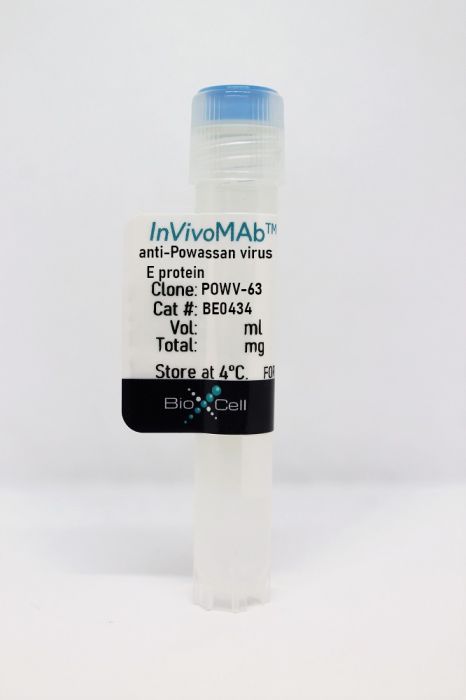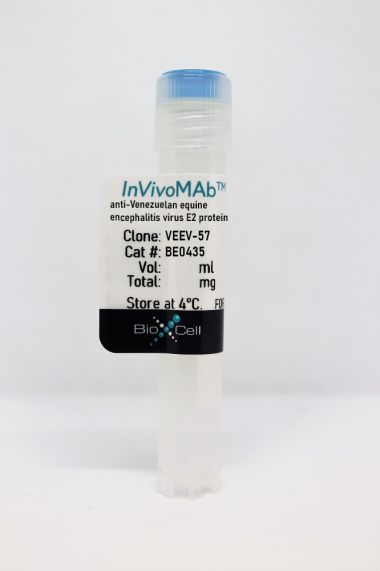InVivoMAb anti-Powassan virus E protein
Product Details
The POWV-63 monoclonal antibody reacts with the envelope (E) protein of Powassan virus (POWV), a tick-borne flavivirus (TBFV), which causes severe to fatal neurological disease in humans. Approximately 10–15% of neuroinvasive POWV infections result in death, and over half of those who survive suffer from significant long-term neurological consequences. The E protein of mammalian TBFVs exhibits approximately 70% sequence similarity, and many of them, such as POWV and tick-borne encephalitis virus (TBEV), are associated with inflammation of the brain. Interest in this research area has been spurred by the lack of vaccinations, and many POWV-neutralizing antibodies (e.g., POWV-63, POWV-80, POWV-4, etc.) have been developed. The POWV-63 antibody has been reported to exhibit potent inhibition (EC50 < 10 ng/ml) of POWV infection in Raji-DCSIGN-R cells, which were treated with C-prM-E proteins of the POWV lineage II strain P0375-based reporter virus particles (RVPs). The specificity of this antibody was verified with hydrogen-deuterium exchange mass spectrometry (HDX-MS) and ELISA against recombinant POWV E protein. The POWV-63 antibody was found to detect an epitope containing or proximal to the DII fusion loop, and this detection requires an intact DII fusion loop. The flow cytometry of TBEV, LGTV, and GGYV C-prM-E-transfected cells depicted a significant cross-reactivity of the POWV-63 antibody with these flaviviruses. Several in vitro experiments showed the neutralization activity of the POWV-63 antibody against DENV-2, SLEV, and ZIKV RVPs as well. Interestingly, this antibody exhibited antibody-dependent enhancement (ADE) effects on mosquito-borne flavivirus (MBFV) infection in K562 cells. Recently, an in vivo experimental study demonstrated that the POWV-63 monoclonal antibody blocks the post-attachment steps in the viral life cycle. In C57BL/6J mice-based in vivo studies, POWV-63 offered significant protection against POWV-SPO, TBFVs, and Langat virus (LGTV).Specifications
| Isotype | Mouse IgG2c, κ |
|---|---|
| Recommended Dilution Buffer | InVivoPure pH 7.0 Dilution Buffer |
| Immunogen | POWV strain SPO or POWV mRNA vaccine |
| Reported Applications |
in vivo protection against POWV in vitro neutralization of POWV Antibody Dependent Enhancement (ADE) Foci reduction neutralization test (FRNT) Flow cytometry ELISA |
| Formulation |
PBS, pH 7.0 Contains no stabilizers or preservatives |
| Endotoxin |
<2EU/mg (<0.002EU/μg) Determined by LAL gel clotting assay |
| Purity |
>95% Determined by SDS-PAGE |
| Sterility | 0.2 µm filtration |
| Production | Purified from cell culture supernatant in an animal-free facility |
| Purification | Protein A |
| Molecular Weight | 150 kDa |
| Storage | The antibody solution should be stored at the stock concentration at 4°C. Do not freeze. |
Recommended Products
in vivo protection against POWV, In vitro neutralization of POWV, Antibody Dependent Enhancement (ADE), Focus reduction neutralization test (FRNT), Flow Cytometry, ELISA
VanBlargan LA, Errico JM, Kafai NM, Burgomaster KE, Jethva PN, Broeckel RM, Meade-White K, Nelson CA, Himansu S, Wang D, Handley SA, Gross ML, Best SM, Pierson TC, Fremont DH, Diamond MS. (2021). "Broadly neutralizing monoclonal antibodies protect against multiple tick-borne flaviviruses" J Exp Med 10.1084/jem.20210174. PubMed
Although Powassan virus (POWV) is an emerging tick-transmitted flavivirus that causes severe or fatal neuroinvasive disease in humans, medical countermeasures have not yet been developed. Here, we developed a panel of neutralizing anti-POWV mAbs recognizing six distinct antigenic sites. The most potent of these mAbs bind sites within domain II or III of the envelope (E) protein and inhibit postattachment viral entry steps. A subset of these mAbs cross-react with other flaviviruses. Both POWV type-specific and cross-reactive neutralizing mAbs confer protection in mice against POWV infection when given as prophylaxis or postexposure therapy. Several cross-reactive mAbs mapping to either domain II or III also protect in vivo against heterologous tick-transmitted flaviviruses including Langat and tick-borne encephalitis virus. Our experiments define structural and functional correlates of antibody protection against POWV infection and identify epitopes targeted by broadly neutralizing antibodies with therapeutic potential against multiple tick-borne flaviviruses.
Huang RY, Krystek SR, Felix N, Graziano RF, Srinivasan M, Pashine A, Chen G. (2018). "Hydrogen/deuterium exchange mass spectrometry and computational modeling reveal a discontinuous epitope of an antibody/TL1A Interaction" MAbs 10.1080/19420862.2017.1393595. PubMed
TL1A, a tumor necrosis factor-like cytokine, is a ligand for the death domain receptor DR3. TL1A, upon binding to DR3, can stimulate lymphocytes and trigger secretion of proinflammatory cytokines. Therefore, blockade of TL1A/DR3 interaction may be a potential therapeutic strategy for autoimmune and inflammatory diseases. Recently, the anti-TL1A monoclonal antibody 1 (mAb1) with a strong potency in blocking the TL1A/DR3 interaction was identified. Here, we report on the use of hydrogen/deuterium exchange mass spectrometry (HDX-MS) to obtain molecular-level details of mAb1's binding epitope on TL1A. HDX coupled with electron-transfer dissociation MS provided residue-level epitope information. The HDX dataset, in combination with solvent accessible surface area (SASA) analysis and computational modeling, revealed a discontinuous epitope within the predicted interaction interface of TL1A and DR3. The epitope regions span a distance within the approximate size of the variable domains of mAb1's heavy and light chains, indicating it uses a unique mechanism of action to block the TL1A/DR3 interaction.



